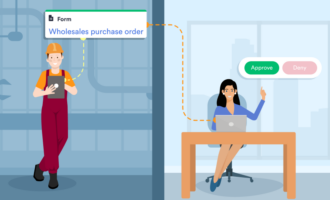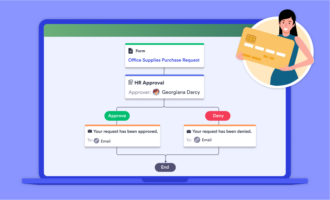Uncertainty isn’t always a bad thing in business. For example, your company may expect to make several purchases from a vendor over a period of time — without knowing the quantity of items or the delivery date.
It may seem odd for a company to sign a contract for future purchases without knowing these details. This is where blanket purchase orders, also sometimes called standing orders, become useful.
Though they require a thorough understanding of future expenses, a blanket purchase order can save you time by setting out terms and conditions before you make those purchases. Many companies take this search for efficiency even further, automating the vital but occasionally tedious task of approving blanket purchase orders.
Take, for example, a manufacturing company that sets up a blanket purchase order with a parts supplier for a year. Due to inconsistencies, defects, and other factors, some parts may wear out sooner than others. Knowing that new parts will be necessary but not knowing how many or when, the company can anticipate these problems by using a blanket purchase agreement that sets terms for future orders.
Companies use this type of purchase order most often when they’ve found a trusted vendor or supplier. As blanket purchase orders are long-term agreements, they can go a long way toward establishing a symbiotic relationship between buyer and seller — and they’re a nice way to make friends in the business world.
But what is a purchase order anyway?
For the uninitiated, a purchase order is a kind of contract between a buyer and seller that dictates the terms of either single or multiple purchases. The four types of purchase orders are blanket, standard, planned, and contract. Each has its benefits, and there’s a purchase order for basically any purchasing need a company might have.
- A standard purchase order is an agreement for a single purchase that sets out the price, timing, and delivery of the purchase with no bells and whistles — just the terms for a one-time order.
- A planned purchase order is the same as a standard purchase order but with just a tentative schedule for delivery. Companies establish these orders first and release them later, as necessary.
- A contract purchase order is similar to a blanket purchase order, but it only sets out the terms and conditions for future purchases.
Blanket purchase orders, in comparison to the other three types, offer the greatest flexibility. Some also establish a set price, ensuring your company encounters no unexpected costs over the course of the deal. Many companies negotiate discounts into blanket contracts if they purchase a specified quantity of items as well.
Blanket purchase orders are some of the easiest to automate. This gives small businesses that don’t have the time to continually craft and negotiate purchase order agreements a significant advantage.
What are some helpful best practices?
Always vet suppliers before creating a blanket purchase order, especially if they’re new to the industry or you’re unsure of their past performance. While blanket orders don’t guarantee you’ll have to purchase products from a subpar supplier, you can still spend substantial time negotiating terms.
The typical approval process for a purchase order begins when a department or individual in an organization creates a contract request for company stakeholders to approve. In the request, they set out the terms and conditions of a prospective purchase order.
For a blanket purchase agreement, the department or person making the request likely only needs to estimate how much they expect to purchase over a period of time. The accounting team then checks this data and determines whether or not the company can afford the purchase.
If the contract gets internal approval, it goes to the supplier. Once the supplier accepts the contract, the purchase order is activated. On the seller’s end, receiving and accepting a successful purchase order requires a good deal of internal communication and data collection.
How can you automate the purchase order approval process?
If the purchase order approval process sounds like it includes a lot of paperwork for a small business, you’re right. In the past, companies employed scores of clerks and accountants to keep track of this information to ensure accountability. On top of that, the approval process could take ages to complete if you had to track down each stakeholder to fill out the proper forms.
Today, companies have many software options to automate this process and focus their efforts on creating value for consumers instead of administrative functions. Jotform Workflows, for example, provides a platform to make your approval process easier. You and your team members can even approve a request on any device — and you can even do it when you’re on the go through the Jotform Mobile Forms app.
First, you can create your own approval forms with the Jotform Form Builder. Jotform offers several purchase order form templates to get you started. Next, you can create approval steps using your form and add conditional branches and approvers in a drag-and-drop interface to quickly build a workflow with timed updates, notifications, and deadlines.
You can also track the progress of each approval with Jotform Tables or the mobile app without unnecessary delays or meetings.
Automating the purchase order approval process speeds up your purchasing, giving you and your team more time to fulfill long-term goals.
















Send Comment: